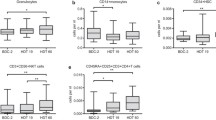Abstract.
Head-down tilt bed rest (HDT) is used as a model for studying the physiological changes occurring in weightlessness during spaceflight. In the present study, eight volunteers were subjected to a strict HDT of –6° for 42 days. Blood samples were obtained 37 and 13 days before, at days 13, 34, and 41 during, and 12, 33, and 47 days after HDT. FACScan analysis was used to determine cell subpopulations. Plasma was used to quantify various circulating hormone levels. Whole blood and reconstituted blood were stimulated with various activators such as phytohaemagglutinin-P (PHA), PHA combined with phorbol-12-myristate 13-acetate (PMA), anti-CD2, anti-CD3, and lipopolysaccharide. Supernatants were collected and analysed for the interleukins IL-1β, IL-2, IL-6, and IL-10, interferon-γ (IFN-γ) and tumour necrosis factor-α (TNF-α). The total number of T lymphocytes and monocytes did not change significantly, whereas the number of polymorphonuclear cells increased during HDT. The percentage of CD2+ and CD3+ cells was increased at day 35 of HDT. The percentage and total number of natural killer cells (CD2+/CD3–/CD56+) was increased 12 days before and 14 days after HDT. TNF-α secretion did not change significantly during HDT. IL-2, IL-10 and IFN-γ were increased at day 34 of HDT. IL-1β levels were increased before and during HDT compared to post-HDT measurements. No significant changes were observed in plasma immunoglobulin, complement factors and other factors of the inflammatory system. Prolactin levels increased slightly but significantly at day 35 of HDT, thyreotropin and growth hormone levels remained virtually unchanged. Cortisol decreased slightly but significantly over the entire duration of the study. The changes observed during HDT do not indicate that the immune system is blunted, and these changes do not seem to correlate with the duration of HDT. Taken together these results show that a HDT does not reproduce the changes in immune responses observed after spaceflight.
Similar content being viewed by others
Author information
Authors and Affiliations
Corresponding author
Additional information
Electronic Publication
Rights and permissions
About this article
Cite this article
Schmitt, D., Schwarzenberg, M., Tkaczuk, J. et al. Head-down tilt bed rest and immune responses. Pflügers Arch - Eur J Physiol 441 (Suppl 1), R79–R84 (2000). https://doi.org/10.1007/s004240000349
Published:
Issue Date:
DOI: https://doi.org/10.1007/s004240000349




